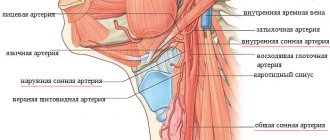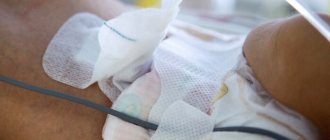Palpation of the heart area. Apex beat
Palpation of the heart area makes it possible to better characterize the apex beat of the heart
, detect a heartbeat, evaluate visible pulsation or detect it, detect tremors of the chest (symptom of “cat purring”).
To determine the apical impulse of the heart, the right hand, palmar surface, is placed on the left half of the patient’s chest in the area from the sternal line to the anterior axillary between the 3rd and 4th ribs (in women, the left mammary gland is first retracted up and to the right). In this case, the base of the hand should be facing the sternum. First, the push is determined with the entire palm, then, without lifting the hand, with the flesh of the end phalanx of the finger placed perpendicular to the surface of the chest (Fig. 38).
Rice. 38. Determination of the apical impulse: a - palmar surface of the hand; b - the end phalanx of the bent finger.
Palpation of the apical impulse can be facilitated by bending the patient's torso forward or by palpation during deep exhalation. In this case, the heart is more closely adjacent to the chest wall, which is also observed in the position of the patient on the left side (in the case of turning on the left side, the heart shifts to the left by about 2 cm, which must be taken into account when determining the location of the push).
When palpating, pay attention to the localization, extent, height and resistance of the apical impulse.
Normally, the apical impulse is located in the 5th intercostal space at a distance of 1-1.5 cm medially from the left midclavicular line. Its displacement can cause an increase in pressure in the abdominal cavity, leading to an increase in the position of the diaphragm (during pregnancy, ascites, flatulence, tumors, etc.). In such cases, the impulse moves up and to the left, as the heart turns up and to the left, taking a horizontal position. When the diaphragm is low due to a decrease in pressure in the abdominal cavity (with weight loss, visceroptosis, emphysema, etc.), the apical impulse moves down and inward (to the right), as the heart turns down and to the right and takes a more vertical position.
An increase in pressure in one of the pleural cavities (with exudative pleurisy, unilateral hydro-, hemo- or pneumothorax) causes a displacement of the heart and, consequently, the apical impulse in the direction opposite to the process. Wrinkling of the lungs as a result of the proliferation of connective tissue (with obstructive pulmonary atelectasis, bronchogenic cancer) causes a displacement of the apical impulse to the painful side. The reason for this is a decrease in intrathoracic pressure in the half of the chest where the shrinkage occurred.
As the left ventricle of the heart enlarges, the apical impulse shifts to the left. This is observed with bicuspid valve insufficiency, arterial hypertension, and cardiosclerosis. With aortic valve insufficiency or narrowing of the aortic opening, the impulse can shift simultaneously to the left (up to the axillary line) and down (to the VI - VII intercostal space). In the case of dilation of the right ventricle, the impulse may also shift to the left, since the left ventricle is pushed by the dilated right ventricle to the left. With a congenital abnormal location of the heart on the right (dextracardia), the apical impulse is observed in the 5th intercostal space at a distance of 1-1.5 cm inward from the right midclavicular line.
With pronounced effusion pericarditis and left-sided exudative pleurisy, the apex beat is not detected.
The normal distribution (area) of the apex beat is 2 cm2. If its area is smaller, it is called limited; if it is larger, it is called diffuse.
Limited apical impulse
noted in cases where the heart is adjacent to the chest with a smaller surface than normal (occurs with emphysema, with a low diaphragm).
Spilled apical impulse
usually caused by an increase in the size of the heart (especially the left ventricle, which occurs with insufficiency of the mitral and aortic valves, arterial hypertension, etc.) and occurs when it is mostly adjacent to the chest. A diffuse apical impulse is also possible with wrinkling of the lungs, high standing of the diaphragm, with a tumor of the posterior mediastinum, etc.
Apex beat height
characterized by the amplitude of vibration of the chest wall in the region of the apex of the heart. There are high and low apical impulses, which are inversely proportional to the thickness of the chest wall and the distance from it to the heart. The height of the apical impulse is directly dependent on the strength and speed of heart contraction (increases with physical activity, anxiety, fever, thyrotoxicosis).
Apex beat resistance
determined by the density and thickness of the heart muscle, as well as the force with which it protrudes the chest wall. High resistance is a sign of hypertrophy of the left ventricular muscle, no matter what causes it. The resistance of the apical impulse is measured by the pressure it exerts on the palpating finger and the force that must be applied to overcome it. A strong, diffuse and resistant apical impulse upon palpation gives the sensation of a dense, elastic dome. Therefore, it is called a dome-shaped (elevating) apical impulse. Such a push is a characteristic sign of aortic heart disease, i.e. insufficiency of the aortic valve or narrowing of the aortic opening.
Heart beat
palpated over the entire palmar surface of the hand and is felt as a shaking of the chest area in the area of absolute dullness of the heart (IV-V intercostal space to the left of the sternum). A pronounced cardiac impulse indicates significant hypertrophy of the right ventricle.
The symptom of “cat purring” is of great diagnostic importance.
: The trembling of the chest resembles the purring of a cat when stroking it. It is formed when blood quickly passes through a narrowed hole, resulting in vortex movements that are transmitted through the heart muscle to the surface of the chest. To identify it, you need to place your palm on those places in the chest where it is customary to listen to the heart. The sensation of a “cat’s purr”, detected during diastole at the apex of the heart, is a characteristic sign of mitral stenosis; during systole in the aorta - aortic stenosis; in the pulmonary artery - pulmonary artery stenosis or patent ductus arteriosus.
In English:
What does sound analysis provide?
Diagnostics requires identifying sounds that do not correspond to the norm. Therefore, an experienced doctor must be able to distinguish the “music” of regular heart contractions from pathological ones.
The muscular and valvular apparatus of the heart are in constant hard work. By driving a mass of blood from the chambers into the vessels, they cause vibration of nearby tissues and transmit sound vibrations to the chest from 5 to 800 Hz per second. The human ear can perceive sound in the range from 16 to 20,000 Hz, with the best sensitivity between 1000 and 4000 Hz. This means that a person does not have enough capabilities for an accurate diagnosis.
It takes practice and attention. Heard sounds should be perceived as information
Having received it, the doctor must:
- evaluate the origin in comparison with the norm;
- suggest the causes of violations;
- characterize.
What methods should a doctor know?
Narrow medical specialization does not exclude the general training of a general practitioner. The standard set of knowledge and skills of a novice doctor necessarily includes:
- personal examination of the patient;
- palpation - palpation of a dense organ, edge to determine consistency and size; pulse, area of the heart - to determine the shock wave, the force of the heart impulse;
- percussion - determining the boundaries of dullness by the nature of the sound obtained by tapping a finger over organs of different densities;
- Auscultation - listening to standard points of the body located above zones that are as close as possible to the movement of fluid inside hollow organs; the occurrence of noise depends on the speed of flow and obstacles.
Let us consider the possible results of using propaedeutics methods in the diagnosis of cardiac pathology.
Shift of the apical impulse to the left and down indicates left ventricular hypertrophy
Percussion technique and data
Percussion allows you to determine the size, configuration, position of the heart and the size of the vascular bundle.
First of all, you should take a position so that you can correctly place the pessimeter finger (press it tightly against the chest and parallel to the border being determined) and so that it is convenient to apply a percussion blow with your finger on the finger.
The heart of children should be percussed quietly, because the child’s chest is relatively thin and with strong impacts, nearby tissues will be involved in the oscillatory movements, which will not make it possible to correctly determine the boundaries of relative and absolute cardiac dullness. When determining absolute dullness of the heart, percussion should be as quiet as possible. It is necessary to percussion from a clear pulmonary sound to cardiac dullness.
Prevalence of cardiac pulsation
The area of protrusion of the cardiac impulse is about 2 cm². If it turns out to be larger, then they speak of a diffuse or widespread shock. With a smaller area it is limited.
Widespread pulsation occurs if the heart's larger surface is adjacent to the chest wall. This is observed:
- with a deep breath;
- pregnancy;
- at, etc.
In the absence of these conditions, a diffuse impulse may be the result of expansion of the heart (all or any of its parts).
A limited cardiac impulse occurs when the heart has a smaller area adjacent to the chest. The reason for this may be:
- emphysema;
- low aperture;
- hydro-, pneumopericardium.
Electrocardiogram
When the heart is excited, a potential difference arises between the excited (negative potential on the surface) and unexcited (positive potential on the surface) areas of the myocardium. Such a potential difference can be recorded using an electrocardiograph (a device for recording the biocurrents of the heart). The human body is a good conductor of current, therefore the biopotentials that arise in the heart can be registered on the surface of the human body. The biopotentials of the heart recorded using an electrocardiograph are called an electrocardiogram.
Rice. 7.6. Normal electrocardiogram in standard lead II
To record cardiac biocurrents, standard taps are used, in which the recording electrodes are located:
Lead I: right arm and left arm;
Lead II: right arm and left leg
Lead III: left arm and left leg.
A normal electrocardiogram (ECG) consists of waves, segments between them and intervals (Fig. 7.6).
The height of the teeth characterizes the characteristics of excitation, the duration - the speed of impulses in the heart. The ECG has 3 upward (positive) waves - P, R, T and two negative, downward waves - Q and S waves.
The P wave characterizes excitation in the atria, its amplitude is 0.2 mV (1/8 R), duration is 0.11 s.
PQ interval - reflects the time from the beginning of atrial depolarization to the beginning of ventricular depolarization and characterizes the speed of excitation in the atria, AV node, His bundle and its branches, its duration is 0.1-0.21 s.
Q wave - characterizes excitation of the interventricular septum, amplitude - ¼ R.
The R wave is the period of excitation coverage of both ventricles; is the main vector of the QRS complex, the amplitude in lead II is 1.6 mV.
The S wave is the period of completion of ventricular depolarization, amplitude is ¼ R.
The maximum duration of the ventricular QRS complex is 0.07-0.09 s.
Wave T (trophic) - the process of repolarization in the ventricles; duration - 0.16-1.24 s, amplitude - ½R.
The QT interval reflects the rate of depolarization (QRS) and repolarization (ST) of the ventricles; it is called electrical ventricular systolic, duration - 0.35-0.44 s.
The interval between the T wave and the subsequent P wave is the electrical diastole of the heart.
The RR interval (duration of the cardiac cycle) allows you to determine the heart rate (60 / RR in s). It is significant that with an increase in heart rate (tachycardia), the diastolic (TP) decreases significantly more than the systolic (QRST).
The electrical axis of the heart is the projection of the average resulting QRS vector onto the frontal plane. Normally, the position of the electrical axis of the heart approximately corresponds to the position of its anatomical axis.
The position of the electrical axis is expressed by the value of the angle alpha (a) formed by the electrical axis of the heart and the positive half of the axis and lead. Options for the position of the electrical axis of the heart: 1) normal, angle a is +30 ... + 69 °, 2) vertical, angle a is +70 ... + 90 °; 3) horizontal, the angle a varies from 0 to 29 °. The position of the electrical axis of the heart depends on both cardiac and post-cardiac factors. In people with a hypersthenic constitution, the electrical axis of the heart has a horizontal position or even a levogram appears. In tall, thin people, the electrical axis of the heart is normally located more vertically, sometimes to the right angle. Deviation of the axis to the right may indicate hypertrophy of the right ventricle, and to the left - left.
There are several methods for determining the electrical axis of the heart. The simplest of them, with sufficient reliability, is the following. Normally, in lead II, the value of the R wave is equal to the sum of the values of the R waves in leads I and III. If the amplitude of the R wave is large in lead I, then they speak of a livogram, if in lead III - a rightogram.








